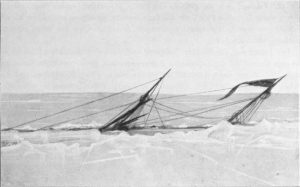Nils Otto Nordenskjöld (1869–1928)
 Otto Nordenskjöld, a Swedish geologist and academic, came from a prominent family of scientists, explorers and humanitarians. He was one of the first geographers with a scholarly background to explore and research in Antarctica.
Otto Nordenskjöld, a Swedish geologist and academic, came from a prominent family of scientists, explorers and humanitarians. He was one of the first geographers with a scholarly background to explore and research in Antarctica.
Expedition to Tierra del Fuego (1895-97)
This expedition to a southern latitude comparable to Sweden’s in the north set out to answer fundamental questions about glaciation and the ice ages, and parallelism in flora and fauna in north and south. He also engaged in ethnographical and linguistic studies of the Fuegian Indians, and investigated possibilities for a European colony here, during which he discovered the scenic area which today is the national park of Torres del Paine.
Expeditions to Alaska (1898) and Northeast Greenland (1900)
In 1898 Nordenskjöld headed to Alaska to study the gold rush, investigate colonization possibilities, and to search for traces of the missing Swedish balloon expedition. Two years later, he joined a Danish expedition to northeast Greenland, where he experienced polar conditions and learned to handle sled dogs.
The Swedish South Polar Expedition (1901–03)
Nordenskjöld bought the ship Antarctic. His plan was to take a small group of scientists to overwinter as far south as possible on the eastern side of the Antarctic Peninsula. The Antarctic would take the rest of the crew and scientists north to do research in the Falklands and Tierra del Fuego, and return to collect them the following spring. Instead, this expedition developed into one of the most astonishing survival stories of the Heroic Age of exploration.
The Antarctic crushed in the ice February 12, 1903
 Nordenskjöld and five companions were dropped at Snow Hill island, more or less as planned, and proceeded to conduct scientific investigations across a wide range of disciplines. They also made a pioneering sledge journey of 33 days and 380 miles (611 km) across unknown land. When the ship tried to return for them the following year, it found its way blocked by thick sea ice. Three men were put ashore to sledge the 75 miles (121 km) to the waiting group with the news of the ship, but their progress was halted by open water. When they returned to their starting point, they found the ship had gone, and it was never to return.
Nordenskjöld and five companions were dropped at Snow Hill island, more or less as planned, and proceeded to conduct scientific investigations across a wide range of disciplines. They also made a pioneering sledge journey of 33 days and 380 miles (611 km) across unknown land. When the ship tried to return for them the following year, it found its way blocked by thick sea ice. Three men were put ashore to sledge the 75 miles (121 km) to the waiting group with the news of the ship, but their progress was halted by open water. When they returned to their starting point, they found the ship had gone, and it was never to return.
Captain Larson had decided to sail into the Weddell Sea in the hope of skirting the sea ice there, but the ship became beset in the ice and eventually was crushed. Twenty men and the ship’s cat were left stranded on the sea ice with whatever they could hastily salvage from the sinking ship. They made an epic 16-day journey across sea ice and open water in a lifeboat to Paulet Island, where they built a hut and stockpiled food for the winter. In the meantime the three stranded men did the same thing at Hope Bay and their story of resourcefulness and improvisation is truly remarkable.
So now the expedition consisted of three groups of men isolated from each other and from any help, facing the oncoming winter. With the exception of one young seaman, all survived in good health until the next spring. Due to a fantastic series of coincidences and several extraordinary boat and ski journeys, all men were re-united at Snow Hill just in time to be rescued by an Argentine ship that was searching for them.
Later Life
Nordenskjöld had previously fallen in love with a young Norwegian girl in Iceland and, on his safe return from Antarctica, they married in 1905. In the same year he took up a professorship of geology and ethnography at Göteborg University, and embarked on an extensive lecture tour of the United Stated and Germany.
Later he undertook voyages in Greenland and Spitsbergen, and planned a 5-year international research expedition to Antarctica with permanent stations, but World War I brought an end to his expedition plans. In 1916 he was sent as part of a somewhat premature delegation to try to negotiate peace in Europe.
In the 1920s Nordenskjöld undertook expeditions to Chile and Peru and led a very busy life working for his university, writing books and papers, organizing conferences and speakers, and planning Swedish emigration to Canada. Nordenskjöld died in 1928, after being struck by a vehicle.